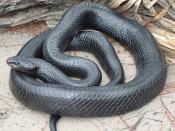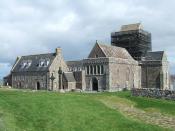Edward Abbey shows a great respect for nature, elevating it perhaps above men in his essay "The Serpents of Paradise". He does this on many levels and in several ways. His writing shows awe for nature in his very descriptions. The joy he takes in nature shows itself also in the powerful imagery he uses. It is a very raw and emotive feeling he projects, while at the same time in a rational scientific light. His love for the natural world and his elevation of it is powerful and stunning.
The writer's diction shows a man who finds the world around him amazing and wishes to understand it in a better fashion. When he describes his first encounters with a snake at his home, he uses several terms of endearment such as "fellow creature" (p. 614) and "Cousin"(abbey, 615). Abbey maintains the act of killing the snake is comparing it to "murder" (abbey, 614) and an affront to morality.
The writer describes the birds' song and his compares it to the flute. His word choice reveals a great love for nature and almost a form of worship.
In addition, his word choice reveals a need to rationalize the world around him through science. His use of the scientific name of various creatures such as the diamondback, "Crolatus atrox"(abbey, 614), and the Gopher snake, "Drymarchon corais couperi" (abbey, 615), shows his deep need to objectively understand nature. Abbey states at one quite clear moment in a clear rational manner that he "is not giving human motives to his snake and bird acquaintances" (Abbey, 617). This again shows a man who has his wording designed to be rational and logical.
The imagery the writer provides continues this sense of elevation. He describes the canyon itself as a powerful entity to...


